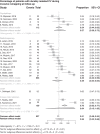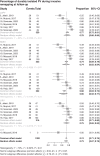Durability of pulmonary vein isolation for atrial fibrillation: a meta-analysis and systematic review
- PMID: 37944133
- PMCID: PMC10664405
- DOI: 10.1093/europace/euad335
Durability of pulmonary vein isolation for atrial fibrillation: a meta-analysis and systematic review
Abstract
Aims: Pulmonary vein isolation (PVI) plays a central role in the interventional treatment of atrial fibrillation (AF). Uncertainties remain about the durability of ablation lesions from different energy sources. We aimed to systematically review the durability of ablation lesions associated with various PVI-techniques using different energy sources for the treatment of AF.
Methods and results: Structured systematic database search for articles published between January 2010 and January 2023 reporting PVI-lesion durability as evaluated in the overall cohort through repeat invasive remapping during follow-up. Studies evaluating only a proportion of the initial cohort in redo procedures were excluded. A total of 19 studies investigating 1050 patients (mean age 60 years, 31% women, time to remap 2-7 months) were included. In a pooled analysis, 99.7% of the PVs and 99.4% of patients were successfully ablated at baseline and 75.5% of the PVs remained isolated and 51% of the patients had all PVs persistently isolated at follow-up across all energy sources. In a pooled analysis of the percentages of PVs durably isolated during follow-up, the estimates of RFA were the lowest of all energy sources at 71% (95% CI 69-73, 11 studies), but comparable with cryoballoon (79%, 95%CI 74-83, 3 studies). Higher durability percentages were reported in PVs ablated with laser-balloon (84%, 95%CI 78-89, one study) and PFA (87%, 95%CI 84-90, 2 studies).
Conclusion: We observed no significant difference in the durability of the ablation lesions of the four evaluated energies after adjusting for procedural and baseline populational characteristics.
Keywords: Atrial Fibrillation; Cryoballoon Ablation; Laser Balloon; Pulmonary Vein Isolation; Pulsed-Field Ablation; Radiofrequency Ablation.
© The Author(s) 2023. Published by Oxford University Press on behalf of the European Society of Cardiology.
Conflict of interest statement
Conflict of interest: T.S. has received research funding from the ‘Swiss Academy of Medical Sciences’ and the ‘Gottfried & Julia Bangerter-Rhyner’ Foundation. J.F.L. has received research funding from the ‘University of Basel’ and the ‘Swiss Heart Foundation’. Philipp Krisai reports speaker fees from BMS/Pfizer. S.K. has received funding from the ‘Stiftung für Herzschrittmacher und Elektrophysiologie’. M.K. reports grants from the Swiss National Science Foundation (Grant numbers 33CS30_148474, 33CS30_177520, 32473B_176178, 32003B_197524), the Swiss Heart Foundation, the Foundation for Cardiovascular Research Basel and the University of Basel, grants from Bayer, grants from Pfizer, grants from Boston Scientific, grants from BMS, grants from Biotronik, grants and personal fees from Daiichi Sankyo, all outside the submitted work. C.S. is a member of the Medtronic Advisory Board Europe and Boston Scientitic Advisory Board Europe, received educational grants from Biosense Webster and Biotronik and a research grant from the European Union’s FP7 programme, and Biosense Webster and lecture and consulting fees from Abbott, Medtronic, Biosense-Webster, Boston Scientific, Microport, and Biotronik all outside the submitted work. P.B. has received research funding from the ‘University of Basel’, the Swiss Heart Foundation and Johnson & Johnson and reports personal fees from Abbott, BMS Pfizer, Boston Scientific, and Bayer, all outside the submitted work. Others have nothing to declare.
Figures





References
-
- Ramirez FD, Reddy VY, Viswanathan R, Hocini M, Jaïs P. Emerging technologies for pulmonary vein isolation. Circ Res 2020;127:170–83. - PubMed
-
- Das M, Wynn GJ, Saeed Y, Gomes S, Morgan M, Ronayne Cet al. . Pulmonary vein Re-isolation as a routine strategy regardless of symptoms. JACC Clin Electrophysiol 2017;3:602–11. - PubMed
-
- Maille B, Das M, Hussein A, Shaw M, Chaturvedi V, Williams Eet al. . Reverse electrical and structural remodeling of the left atrium occurs early after pulmonary vein isolation for persistent atrial fibrillation. J Interv Card Electrophysiol 2020;58:9–19. - PubMed
-
- Al Jefairi N, Camaioni C, Sridi S, Cheniti G, Takigawa M, Nivet Het al. . Relationship between atrial scar on cardiac magnetic resonance and pulmonary vein reconnection after catheter ablation for paroxysmal atrial fibrillation. J Cardiovasc Electrophysiol 2019;30:727–40. - PubMed
Publication types
MeSH terms
LinkOut - more resources
Full Text Sources
Medical
Research Materials

